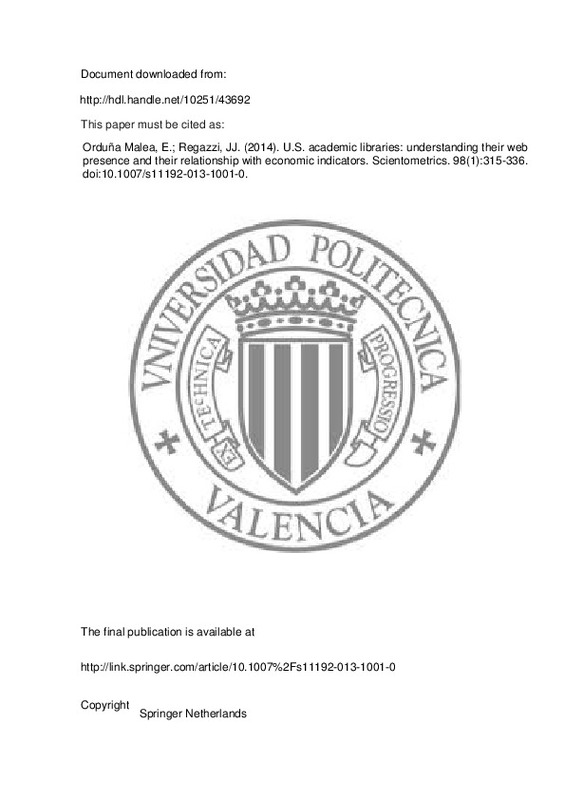Adecannby, J. (2011). Web link analysis of interrelationship between top ten African universities and world universities. Annals of library and information studies, 58(2), 128–138.
Aguillo, I. F. (2009). Measuring the institutions’ footprint in the web. Library Hi Tech, 27(4), 540–556.
Aguillo, I. F., Ortega, J. L., & Fernández, M. (2008). Webometric Ranking of World Universities: Introduction, methodology, and future developments. Higher education in Europe, 33(2/3), 234–244.
[+]
Adecannby, J. (2011). Web link analysis of interrelationship between top ten African universities and world universities. Annals of library and information studies, 58(2), 128–138.
Aguillo, I. F. (2009). Measuring the institutions’ footprint in the web. Library Hi Tech, 27(4), 540–556.
Aguillo, I. F., Ortega, J. L., & Fernández, M. (2008). Webometric Ranking of World Universities: Introduction, methodology, and future developments. Higher education in Europe, 33(2/3), 234–244.
Aguillo, I. F., Ortega, J. L., Fernandez, M., & Utrilla, A. M. (2010). Indicators for a webometric ranking of open Access repositories. Scientometrics, 82(3), 477–486.
Arakaki, M., & Willet, P. (2009). Webometric analysis of departments of librarianship and information science: A follow-up study. Journal of information science, 35(2), 143–152.
Arlitsch, K., & O’Brian, P. S. (2012). Invisible institutional repositories: Addresing the low indexing ratios of IR in Google Scholar. Library Hi Tech, 30(1), 60–81.
Bar-Ilan, J. (1999). Search engine results over time—A case study on search engine stability”. Cybermetrics, 2/3. Retrieved February 18, 2013 from http://www.cindoc.csic.es/cybermetrics/articles/v2i1p1.html.
Bar-Ilan, J. (2001). Data collection methods on the Web for informetric purposes: A review and analysis. Scientometrics, 50(1), 7–32.
Bermejo, F. (2007). The internet audience: Constitution & measurement. New York: Peter Lang Pub Incorporated.
Buigues-Garcia, M., & Gimenez-Chornet, V. (2012). Impact of Web 2.0 on national libraries. International Journal of Information Management, 32(1), 3–10.
Chu, H., He, S., & Thelwall, M. (2002). Library and information science schools in Canada and USA: A Webometric perspective. Journal of education for Library and Information Science, 43(2), 110–125.
Chua, Alton, Y. K., & Goh, D. H. (2010). A study of Web 2.0 applications in library websites. Library and Information Science Research, 32(3), 203–211.
Gallego, I., García, I.-M., & Rodríguez, L. (2009). Universities’ websites: Disclosure practices and the revelation of financial information. The International Journal of Digital Accounting Research, 9(15), 153–192.
Gomes, B. & Smith, B. T. (2003). Detecting query-specific duplicate documents. [Patent]. Retrieved February 18, 2013 from http://www.patents.com/Detecting-query-specific-duplicate-documents/US6615209/en-US .
Harinarayana, N. S., & Raju, N. V. (2010). Web 2.0 features in university library web sites. Electronic Library, 28(1), 69–88.
Lewandowski, D., Wahlig, H., & Meyer-Bautor, G. (2006). The freshness of web search engine databases. Journal of Information Science, 32(2), 131–148.
Mahmood, K., & Richardson, J. V, Jr. (2012). Adoption of Web 2.0 in US academic libraries: A survey of ARL library websites. Program, 45(4), 365–375.
Orduña-Malea, E., & Ontalba-Ruipérez, J-A. (2012). Selective linking from social platforms to university websites: A case study of the Spanish academic system. Scientometrics. (in press).
Ortega, J. L., & Aguillo, I. F. (2009). Mapping World-class universities on the Web. Information Processing and Management, 45(2), 272–279.
Ortega, José L. & Aguillo, Isidro F. (2009b). North America Academic Web Space: Multicultural Canada vs. The United States Homogeneity. In: ASIST & ISSI pre-conference symposium on informetrics and scientometrics.
Phan, T., Hardesty, L., Sheckells, C., & George, A. (2009). Documentation for the academic libraries survey (ALS) public-use data file: Fiscal year 2008. Washington DC: National Center for Education Statistics. Institute of Education Sciences U.S. Department of Education.
Qiu, J., Cheng, J., & Wang, Z. (2004). An analysis of backlinks counts and web impact factors for Chinese university websites. Scientometrics, 60(3), 463–473.
Regazzi, J. J. (2012a). Constrained?—An analysis of U.S. Academic Libraries and shifts in spending, staffing and utilization, 1998–2008. College and Research Libraries, 73(5), 449–468.
Regazzi, J. J. (2012b). Comparing Academic Library Spending with Public Libraries, Public K-12 Schools, Higher Education Public Institutions, and Public Hospitals Between 1998–2008. Journal of Academic Librarianship, 38(4), 205–216.
Rousseau, R. (1999). Daily time series of common single word searches in AltaVista and NorthernLight. Cybermetrics, 2/3. Retrieved February 18, 2013 from http://www.cindoc.csic.es/cybermetrics/articles/v2i1p2.html .
Sato, S., & Itsumura, H. (2011). How do people use open access papers in non-academic activities? A link analysis of papers deposited in institutional repositories. Library, Information and Media Studies, 9(1), 51–64.
Scholze, F. (2007). Measuring research impact in an open access environment. Liber Quarterly: The Journal of European Research Libraries, 17(1–4), 220–232.
Smith, A. G. (2011). Wikipedia and institutional repositories: An academic symbiosis? In: Proceedings of the ISSI 2011 conference. Durban, South Africa, 4–7 July 2011. Retrieved February 18, 2013 from http://www.vuw.ac.nz/staff/alastair_smith/publns/SmithAG2011_ISSI_paper.pdf .
Smith, A.G. (2012). Webometric evaluation of institutional repositories. In: Proceedings of the 8th international conference on webometrics informetrics and scientometrics & 13th collnet meeting. Seoul (Korea), 722–729.
Smith, A., & Thelwall, M. (2002). Web impact factors for Australasian Universities. Scientometrics, 54(3), 363–380.
Tang, R., & Thelwall, M. (2008). A hyperlink analysis of US public and academic libraries’ web sites. Library Quarterly, 78(4), 419–435.
Thelwall, M. (2008). Extracting accurate and complete results from search engines: Case study Windows Live. Journal of the American Society for Information Science and Technology, 59(1), 38–50.
Thelwall, M. (2009). Introduction to webometrics: Quantitative web research for the social sciences. San Rafael: Morgan & Claypool.
Thelwall, M., & Sud, P. (2011). A comparison of methods for collecting web citation data for academic organisations. Journal of the American Society for Information Science and Technology, 62(8), 1488–1497.
Thelwall, M., Sud, P., & Wilkinson, D. (2012). Link and co-inlink network diagrams with URL citations or title mentions. Journal of the American Society for Information Science and Technology, 63(10), 1960–1972.
Thelwall, M., & Zuccala, A. (2008). A University-centred European Union link analysis. Scientometrics, 75(3), 407–442.
Uyar, A. (2009a). Google stemming mechanisms. Journal of Information Science, 35(5), 499–514.
Uyar, A. (2009b). Investigation of the accuracy of search engine hit counts. Journal of Information Science, 35(4), 469–480.
Zuccala, A., Thelwall, M., Oppenheim, C., & Dhiensa, R. (2007). Web intelligence analyses of digital libraries: A case study of the National Electronic Library for Health (NeLH). Journal of Documentation, 63(4), 558–589.
[-]







![[Cerrado]](/themes/UPV/images/candado.png)


